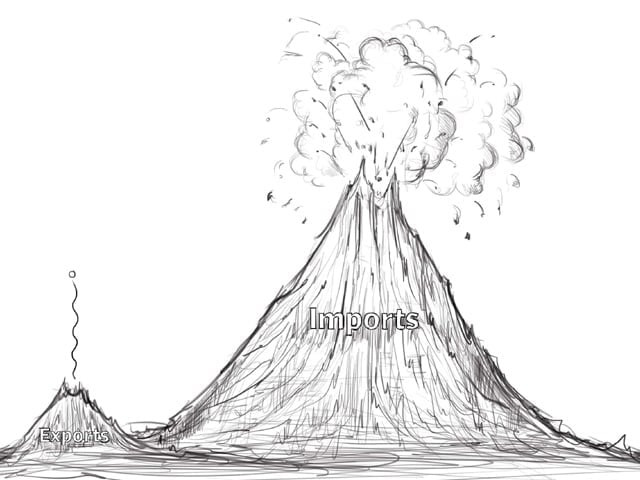Fundamental issues: The disconnect in Pakistan’s trade and GDP growth
Contrary to regional trends, there is paradox underlying Pakistan’s growth trajectory.

In the recently-concluded American Business Council Economic Summit, titled ‘Beyond Borders: Trade Treaties and their Implication’, I presented the hypothesis that “in all successful economies, GDP growth has a direct correlation with trade growth”.
Trade – the act of buying and selling goods and services – is to me a key barometer to judge an economy’s vibrancy and growth. For any given country, it reflects the cumulative value of total imports and exports. The higher the value addition by the domestic producer, the higher will be the selling price and transaction value.
On the face of it, Pakistan’s trade has come a long way from $2.2 billion in 1970, to almost $57 billion in 2010 – an almost 25 fold increase. To judge whether this performance is great, average or poor, one needs to compare it with other economies in the region. To me, India and Bangladesh are excellent benchmarks. During the same period, these two countries increased trade 175 and 45 times – clearly outperforming Pakistan.
Diving into global trade data, we see that Pakistan’s trade performance was par excellence from 1970 to 1990; significantly better than both India and Bangladesh (see graph 1). By 1990, our trade was 39% of GDP, versus 20% for Bangladesh and only 15% for India.
However, in the last 20 years, our trade has plunged while India and Bangladesh have clocked impressive trade growth above the global average of 39%. Bangladesh and India’s trade performance reached 43% and 50% of GDP respectively in 2010, while Pakistan’s dropped to a dismal 32%.
For perspective, countries which have a strong industrial and services sector deliver trade figures above 100% of their GDP: for eg, Singapore (385%), Malaysia (177%), Thailand (125%), and South Korea (102%). The reason their trade figures are greater than their GDP is reflective of their undertaking a significant amount of trade outside their countries’ borders via offices, branches and manufacturing operations in foreign countries.
Does our trade policy drive GDP growth?
If one reviews trade growth and GDP growth figures over time, it is normal to see them grow in tandem in all good economies. On average, global trade and GDP have been growing 7.2% and 5.4% per annum respectively over the past 20 years. For emerging markets, including countries like India, Bangladesh and the Asian Tigers, trade growth is either equal, or in most cases higher, than GDP growth.
In our case, trade grew 1.2% lower than our GDP, while on a global basis, trade has grown 1.8% ahead of global GDP growth on average. If you try to plot Pakistan’s trade as percentage of GDP and GDP on a graph, it is shocking to discover that there no correlation between GDP growth and trade growth (see graph 2).
If similar calculation is done for India, Bangladesh or for the entire world, we find clear-cut growth trends and a strong correlation between GDP and trade growth. Table 1 shows the correlation coefficients for our two neighbours, as well as the world. It clearly confirms that trade drives GDP growth in these countries, as they all have a high correlation coefficient of 0.9 or 1.0.
On the other hand, Pakistan’s performance over the last two decades is negatively correlated to GDP growth, which indicates the presence of a parallel, yet vibrant and large undocumented economy. It may also show the impact of constant foreign loans and aid, which have driven our GDP growth over the years. Trade, clearly, does not play as significant a role as it does in all other emerging economies.
Why are Pakistan’s trade and GDP growth not correlated?
Key among the many factors impacting trade performance is a lack of long-term economic policies that drives trade. Investors, both local and foreign, need to have a clear view of consistent fiscal and trade policies, without which no investment will flow into our country.
In addition, poor security, sporadic energy access, deteriorating infrastructure, as well as poor overall governance has hammered our ability to drive trade or to attract international trade to Pakistan. 58% of our trade is composed of “imports”, which predominantly consist of consumables, electronic goods, food items, and petroleum products – but not plant and machinery, which drive long-term sustainable economic growth.
Weak intellectual property legislation also discourages trade and foreign investment to enter and access our markets. Also, as I discussed in a previous article, decades of protectionist policies have rendered our industries inefficient and uncompetitive: until the early 1990s, tariffs were as high as 90%.
Other issues that will help drive trade include the signing of more Free Trade Agreements with trading partners. These will provide the private sector greater access to other countries and regions, improve infrastructure. We also need to work on access to energy and inland logistics, lowering port and airport charges, streamline customs operations and border controls, and increase the availability of skilled human resources. We also need to significantly increase investment in education and skill building.
Without a 360 degree approach to fixing the weak aspects of our economy, fixing our issues in trade will not be possible.
THE WRITER WORKS IN THE CORPORATE SECTOR AND IS ACTIVE ON VARIOUS BUSINESS FORUMS AND TRADE BODIES
Published in The Express Tribune, October 1st, 2012.



















COMMENTS
Comments are moderated and generally will be posted if they are on-topic and not abusive.
For more information, please see our Comments FAQ